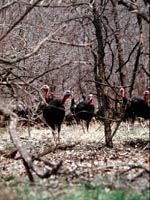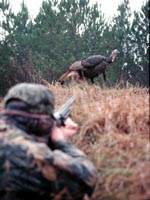
|
Features
|
|
|
|
Books
|
|
|
|
Fun & Games
|
|
|
|
Contact Us
|
|
|
John's Journal... Entry 241, Day 4
SPACE-AGE GOBBLERS WITH DON TAYLOR
The Slue-Foot Gobbler
 Editor's
Note: Global Positioning Systems (GPS) is a system of satellites that
circle the earth and give off signals. Each GPS satellite transmits its
precise location (position and elevation) and the start time of the transmission.
A GPS receiver acquires the signal and then measures the interval between
transmission and receipt of the signal to determine the distance between
the receiver and the satellite-a process called ranging. Once the receiver
has computed range for at least three satellites, the receiver's location
on the surface of the earth can be determined. Each satellite transmits
two types of data, almanac and ephemeris. Almanac data, general information
on the location and health of each satellite on the constellation, can
be collected from any satellite. A receiver with a current almanac in
its memory knows where in the sky to look for satellites, given its last
known position and the time of day. Ephemeris data is the precise satellite
positioning information that is used for ranging. Each satellite transmits
its own ephemeris data. Both almanac and ephemeris data are required for
a GPS receiver to locate and acquire satellites quickly and compute your
position. GPS produces accuracies of about 27 yards or better, bringing
you within visual range of a destination or a target. Most GPS receivers
allow you to log waypoints, either by number or name, which remain in
its memory until you either delete it or change it. Regardless of your
distance from a waypoint, the computer can calculate the direction you
need to travel and the distance from it. This week, Don Taylor, a longtime
turkey hunter from Alabama, shares the experiences he's had hunting with
his GPS receiver.
Editor's
Note: Global Positioning Systems (GPS) is a system of satellites that
circle the earth and give off signals. Each GPS satellite transmits its
precise location (position and elevation) and the start time of the transmission.
A GPS receiver acquires the signal and then measures the interval between
transmission and receipt of the signal to determine the distance between
the receiver and the satellite-a process called ranging. Once the receiver
has computed range for at least three satellites, the receiver's location
on the surface of the earth can be determined. Each satellite transmits
two types of data, almanac and ephemeris. Almanac data, general information
on the location and health of each satellite on the constellation, can
be collected from any satellite. A receiver with a current almanac in
its memory knows where in the sky to look for satellites, given its last
known position and the time of day. Ephemeris data is the precise satellite
positioning information that is used for ranging. Each satellite transmits
its own ephemeris data. Both almanac and ephemeris data are required for
a GPS receiver to locate and acquire satellites quickly and compute your
position. GPS produces accuracies of about 27 yards or better, bringing
you within visual range of a destination or a target. Most GPS receivers
allow you to log waypoints, either by number or name, which remain in
its memory until you either delete it or change it. Regardless of your
distance from a waypoint, the computer can calculate the direction you
need to travel and the distance from it. This week, Don Taylor, a longtime
turkey hunter from Alabama, shares the experiences he's had hunting with
his GPS receiver.
 The
hunt I made for the Slue-Foot Gobbler illustrates how a GPS receiver can
help you get your bird. My hunting companions and I had named one bird
that had whipped us repeatedly Slue-Foot because of his funny gait. This
turkey gobbled well from the roost. Then he would fly down within 60 or
70 yards of a calling position and strut and drum to get a hen to come
to him. If she didn't show herself, he wouldn't move any closer to where
he'd heard the call. One day I decided to chase Slue Foot. As he gobbled
walking away from me, I tried to stay close enough to hear him when he
gobbled yet far enough away so he couldn't see me. I followed him across
the top of a ridge and down the side of the ridge to a little bench where
he had set up a strutting zone. Slue Foot could see everything coming
up the side of the mountain from this vantage point. When he gobbled,
he could spot a hen coming from 150 yards away. I had absolutely no way
of moving close to the gobbler without his seeing me from the bench. Through
my binoculars, I watched the gobbler until he left the bench and went
back up the mountain. I moved down to the bench, cut brush, made a natural
blind, took a GPS reading on the blind and then left the area. Before
daylight the next morning, I used my GPS receiver to "Navigate" in to
the bench and the blind from a different direction than the turkey would
come from and waited on him. When I heard Slue Foot gobble, I gave a few
purrs to make him think a hen had reached his bench before he had. At
about 10:00 a.m., I saw Slue Foot coming at about 100 yards. I never called
again as the bird moved down to the bench to gobble, strut and call up
his hens. My hand-held GPS receiver had allowed me to find the bench and
the blind in the dark and bag Slue Foot.
The
hunt I made for the Slue-Foot Gobbler illustrates how a GPS receiver can
help you get your bird. My hunting companions and I had named one bird
that had whipped us repeatedly Slue-Foot because of his funny gait. This
turkey gobbled well from the roost. Then he would fly down within 60 or
70 yards of a calling position and strut and drum to get a hen to come
to him. If she didn't show herself, he wouldn't move any closer to where
he'd heard the call. One day I decided to chase Slue Foot. As he gobbled
walking away from me, I tried to stay close enough to hear him when he
gobbled yet far enough away so he couldn't see me. I followed him across
the top of a ridge and down the side of the ridge to a little bench where
he had set up a strutting zone. Slue Foot could see everything coming
up the side of the mountain from this vantage point. When he gobbled,
he could spot a hen coming from 150 yards away. I had absolutely no way
of moving close to the gobbler without his seeing me from the bench. Through
my binoculars, I watched the gobbler until he left the bench and went
back up the mountain. I moved down to the bench, cut brush, made a natural
blind, took a GPS reading on the blind and then left the area. Before
daylight the next morning, I used my GPS receiver to "Navigate" in to
the bench and the blind from a different direction than the turkey would
come from and waited on him. When I heard Slue Foot gobble, I gave a few
purrs to make him think a hen had reached his bench before he had. At
about 10:00 a.m., I saw Slue Foot coming at about 100 yards. I never called
again as the bird moved down to the bench to gobble, strut and call up
his hens. My hand-held GPS receiver had allowed me to find the bench and
the blind in the dark and bag Slue Foot.
TOMORROW: GIVE A TURKEY TO A FRIEND
Check back each day this week for more about SPACE-AGE GOBBLERS WITH DON TAYLOR ...
Day 1 - GPSing Albert
Day 2 - Be Lost No More
Day 3 - Hunt Non-Pressured Gobblers And Create
A Hunting Plan Using Your GPS
Day 4 - The Slue-Foot Gobbler
Day 5 - Give A Turkey To A Friend